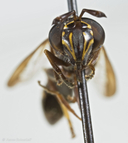notes ====== Specimen Details ======
The photo here shows the female appearing at the right in the specimen box from the 1st photo of this series. The specimen is from the California Academy of Sciences and was collected in Querétaro, Mexico on May 16, 1979 by J. R. Powers. The species determination was made by cerioidine expert F. C. Thompson.
====== Identification Details ======
This species was originally described in 1853 as Ceria arietis by H. Loew (see bottom of page at this BHL link). It was listed under genus Polybiomyia here in the 1976 catalog of Thompson, Vockeroth, & Sedman. Indeed, the specimens key to genus Polybiomyia in the 2010 ''Manual of Central American Diptera'' (see couplets 4 & 5 here).
Unfortunately, none of the species keys covering Mexican Cerioidini that I currently know of (e.g. Williston(1892), Curran(1924), Shannon(1925), Curran(1941)) include the species P. arietis. [Update...see postscript below!] However, though I have no reading comprehension of German, I was still able to gather enough from using Google Translate to see that Loew's original description fits these specimens well. Apparently Loew chose the epithet arietis (from the Latin root arie- =s, -t for ''ram'') because the two contiguous U-shaped pollinose markings on the 3rd tergite gave him the impression of a ram's horns. (Though it should be noted that many other cerioidines also have such paired, 'U'-shaped markings on abdominal segments T3 & T4...e.g. Sphiximorpha willistoni, Polybiomyia townsendi, and more.)
For reference, Kahl's 1897 remarks here may be helpful in separating P. arietis from the similar-looking Ceria signifera of Loew (now Polybiomyia signifera) and Ceria willistoni of Kahl (now Sphiximorpha willistoni). From these revised genus placements, P. signifere should have a complete post-metacoxal bridge, and S. willistoni should lack one (though those characters won't be visible in most photos). Another reference item of possible interest: while Loew only described the male of P. arietis, the 1893 discussion of Ceria arietis by Giglo-Tos provides info on the female.
[Note: Although the species determination for the specimen in this post was made by the foremost ceriodine expert, I still like to try to identify directly the specimens I study...and write down my findings...as it helps me learn and retain things! And, hopefully, it can also help other readers in sharing observations, references, insights, and delights :-] ====== PostScript (4/4/24) ======
I recently learned there is a key that appears to cover all Polybiomyia species worldwide. It's at the end of the paper:
Thompson, F.C. & Wyatt, N. (2015). A new Peruvian cerioidine flower fly (Diptera: Syrphidae). Entomologist's Monthly Magazine 151: 155-160.
photo category: Animal - Invertebrate-Insect
